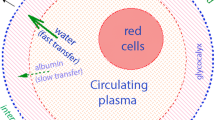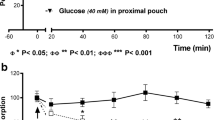Summary
The effects on the14CO2 expiratory patterns of the nature and administration route of the injection fluid containing [14C]-glucose were studied. Li the case of rapid intravenous injection, no difference in the radiorespirometric pattern was found with different glucose concentrations and volumes of the aqueous injection fluid. With intravenous injection, lower P1 heights and longer plateaus were recorded with the [14C]-glucose blood mixture as compared to the aqueous injection fluid. This result indicates that [14C]-glucose in the aqueous fluid injected into the blood vessel could be supplied into organs or tissues before mixing with the blood fluid in the blood vessel system. It is also suggested that larger amounts of [14C]-glucose are taken up into organs and tissues when the label was in aqueous solution rather than blood.
In the case of intraduodenal infusion, a trace of glucose in a small volume (0.05 ml) of aqueous solution gave a similar radiorespirometric pattern to that given by intravenous injection of aqueous fluid. This indicates that there was fast absorption of glucose by the intestinal mucosa, which was not rate-limiting. A relatively large volume and very high concentration of glucose in the infusion fluid caused suppression of the radiorespirometric pattern. This may reflect physical suppression of intestinal peristalsis.
Similar content being viewed by others
References
Momose Y., Shigematsu A. (1989): Radiorespirometric patterns of14C-substrates in rats (I). Eur. J. Drug Metab. Pharmacokinet., 14, 187–194.
Wang C.H. (1971): Radiorespirometry. Meth. Biochem. Anal., 12, 311–367.
Pardridge W.M. (1983): Brain metabolism: a perspective from the blood-brain barrier. Physiol. Rev., 63, 1481–1535.
Oldendorf W.H. (1971): Brain uptake of radiolabeled amino acids, amines, and hexoses after arterial injection. Am. J. Physiol., 224, 1629–1639.
Vernon R.G., Walker D.G. (1972): Glucose metabolism in the developing rat. Biochem. J., 127, 521–529.
Pappenheimer J.R., Setchell B.P. (1973): Cerebral glucose transport and oxygen consumption in sheep and rabbits. J. Physiol., 253, 529–551.
Sokoloff L., Reivich M., Kennedy C., et al. (1977): The [14C] deoxyglucose method for the measurement of local cerebral glucose utilization: theory, procedure and normal value in the conscious and anesthetized albino rat. J. Neurochem., 28, 897–916.
Author information
Authors and Affiliations
Rights and permissions
About this article
Cite this article
Momose, Y., Shigematsu, A. Radiorespirometric patterns of [14C]-substrates in rats. II. differences with the nature and administration route of the injection fluid. European Journal of Drug Metabolism and Pharmacokinetics 16, 35–41 (1991). https://doi.org/10.1007/BF03189872
Received:
Issue Date:
DOI: https://doi.org/10.1007/BF03189872




